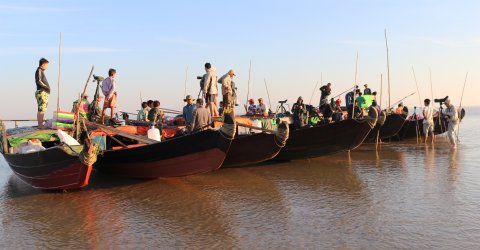
Learning from Experience: How indigenous peoples and local communities contribute to wetland conservation in Asia and Oceania
I would like to share what I tell my communities and those who use the resources in our wetlands, be proud that you live in and access the wetland’s rich resources, look after these God given resources. We should hand our wetlands to our children in the same or in better state that we received them.
Ratu Wiliame Katonivere (Fiji)
Sixteen newly published case studies in Learning from Experience illustrate the powerful role that indigenous peoples and local communities play in wetland wise use and conservation across Asia and Oceania. Fifteen organisations supported and participated in the development of these case studies, including government ministries, International Organisation Partners of the Ramsar Convention on Wetlands, NGOs and research institutes.
The cultural values of Ramsar Sites in Asia and Oceania are very high. In Asia 94 % of listed sites include cultural values among their range of recognised ecosystem services. In Oceania this applies to almost all sites (98 %). Despite the high importance of cultural services, however, only 18.3% of Asian and Oceanic wetlands currently have data on cultural characteristics* relevant for the designation of Ramsar Sites (Ramsar Sites Information Service, November 2017).
National Reports submitted to the Ramsar Secretariat in 2014 reveal that 51% of Contracting Parties in Asia and 83% in Oceania specifically involved local stakeholders in the selection of new Ramsar Sites. Promoting stakeholder participation in decision-making was practiced by 60% of Asian and all Oceanic Contracting Parties.
The sixteen case studies presented in Learning from Experience cover thirteen countries and are grouped within seven good practice themes, such as the application of traditional beliefs and knowledge for wetland management, involvement in Ramsar processes, and adopting alternative sustainable livelihoods. These good practice themes also provide the basis for a suite of recommendations to strengthen the role of indigenous people and local communities in wetland management, including deeper involvement in Ramsar processes, in line with the Ramsar Strategic Plan 2016-2024.
Two inspirational community leaders from the region - Tui Macuata Ratu Wiliame Katonivere (Fiji) and Mr. Abbas Sayyied Sarwat Al-Ismaeeli (Iraq) - also contributed forewords highlighting the vital importance of collaboration between indigenous peoples, local communities, governments and environmental organisations to conserve wetlands for future generations.
The perspective of these two community leaders matches that of the Ramsar Strategic Plan 2016-2024, which recognizes that the wise and customary use of wetlands by indigenous peoples and local communities can play an important role in their conservation, and encourages Contracting Parties to promote, recognize and strengthen active participation of indigenous peoples, as key stakeholders for conservation and integrated wetland management.
This report was made possible thanks to a generous grant from the MAVA Foundation and the involvement of 15 government ministries, International Organisation Partners of the Ramsar Convention, NGOs and research institutes in the Asia and Oceania regions who shared their case studies, including the Department of Environment and Natural Resources (Philippines), GIZ-COSERAM, Executive Committee for Controlled Burning in Handa Highland (Japan), Wetlands International Japan, Food and Agriculture Organization of the United Nations (Lao PDR), IIEST (India), Tata Institute of Social Sciences (India), Ministry of Water Resources (Iraq), Ministry of Science and Technology (Iraq), Biodiversity and Nature Conservation Association (BANCA, Myanmar), Flinders University - Ngarrindjeri Regional Authority (Australia), National Wetland Trust (New Zealand), Waikato River Authority (New Zealand), Landcare Research (New Zealand), CIWP - the Conservation of Iranian Wetlands Project (Iran, supported by the GEF & UNDP), WWF-Pacific (Fiji, PNG), and Peel-Harvey Catchment Council (Australia).
This publication was prepared in the context of the Ramsar Convention Secretariat project “Conservation of the natural and cultural heritage in wetlands: Global leadership for an integrated approach through the Ramsar Convention” (March 2015-March 2018), in line with Decision SC53-15.
* The Ramsar Convention’s 9th COP adopted in 2005 in Resolution IX.21 cultural characteristics relevant for the designation of Ramsar Sites and agreed “…that in the application of the existing criteria for identifying Wetlands of International Importance, a wetland may also be considered of international importance when, in addition to relevant ecological values, it holds examples of significant cultural values, whether material or non-material, linked to its origin, conservation and/or ecological functioning.”